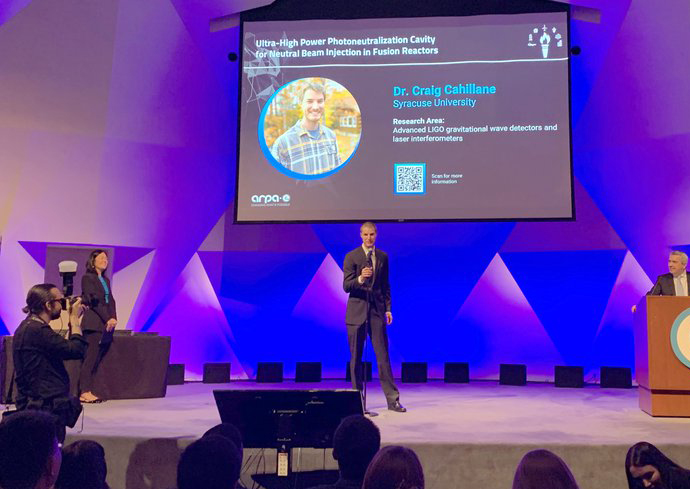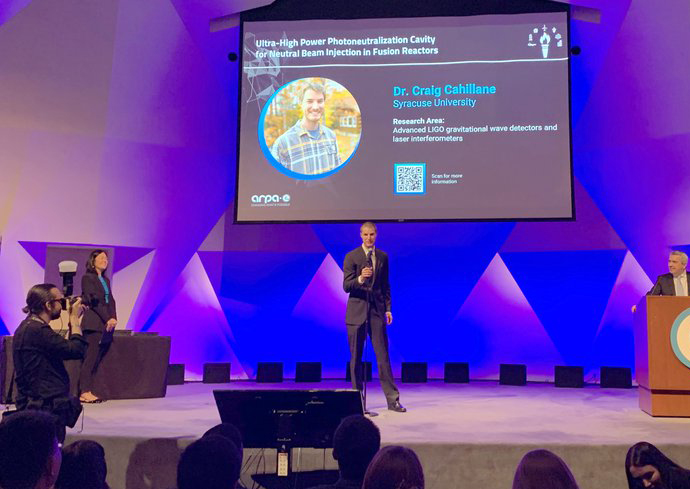Craig Cahillane, assistant professor of physics in the College of Arts and Sciences, has been named an Inspiring Generations of New Innovators to Impact Technologies in Energy 2024 (IGNIITE 2024) award recipient. As one of only 23 winners across the country, Cahillane receives $500,000 in funding to support his work with fusion energy optimization. In total, approximately $11.5 million was distributed to early-career scientists and engineers through the IGNIITE 2024 program.
IGNIITE is led by the U.S. Department of Energy Advanced Research Projects Agency-Energy (ARPA-E), which promotes and funds research and development of advanced energy technologies to ensure that the U.S. maintains its technological leadership in those areas. The prize will support Cahillane’s project, “Ultra-High Power Photoneutralization Cavity for Neutral Beam Injection in Fusion Reactors,” which has the potential to make fusion reactors nearly twice as efficient as current technology.

Perhaps the most common example of nuclear fusion happens on Earth’s Sun. The Sun generates its energy when its hydrogen atoms are heated so much that they speed up and collide violently. As a result, they fuse together to create helium atoms with the byproduct being the emission of massive amounts of energy. If scientists could develop a steady and reliable way to produce similar fusion power on Earth, it could present a commercially viable energy source.
Researchers are currently working to harness prolonged nuclear fusion in the lab. To do this, it is necessary to generate and sustain plasmas, which are produced when gases are heated such that their electrons become freed from their atomic nuclei. In this state, scientists can stimulate ions so they smash into one another, fuse and release energy. But because plasmas are so unstable, researchers must develop methods to contain them.
The Sun’s plasma is held together by gravity and pressure. On Earth, scientists use processes such as magnetic confinement to control and manipulate plasmas in the lab. Any fusion device must generate more heat than it loses to become self-sustaining. Energy is readily lost via plasma loss and X-rays expelled by the super-heated plasma. One popular way of reheating and refueling the reactor is photoneutralization.
With the IGNIITE grant, Cahillane and his team will be working to demonstrate how ultra-high power laser technology can enable a large-scale commercial fusion reactor. They will work to develop a photoneutralization cavity prototype that has the capacity to improve the efficiency of magnetic-confinement fusion reactors.

“Neutralization is important for fusion reactors because you need to somehow reheat and refuel your reactor,” says Cahillane. “One popular method is neutral beam injection, which is useful because the neutral beam can be made of reactor fuel. This recombines with the fusion plasma inside the reactor, dumping a lot of energy into the reactor to keep the fusion plasma hot.”
This project could mark an important first as no one to their knowledge has pushed a small cavity to such extreme power levels before.
“The photoneutralization cavity, if successful, could replace gas-cell based neutralization, making the entire reactor much more efficient overall, eliminating a huge drain on the energetics of a commercial fusion reactor,” Cahillane says.
Learn more about the award and Cahillane’s research on the College of Arts and Sciences’ website and discover more about IGNIITE 2024.



